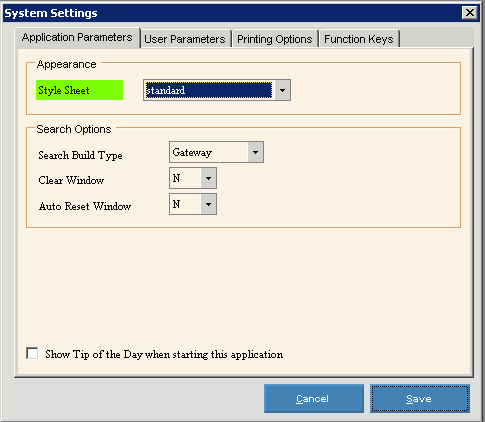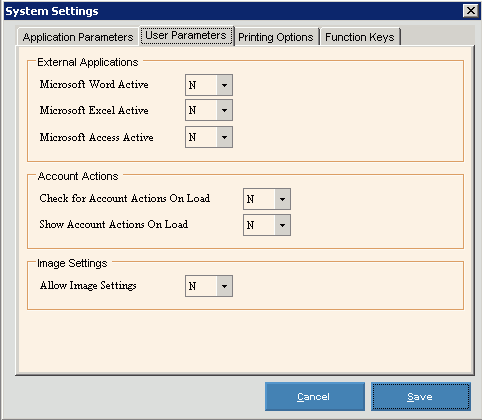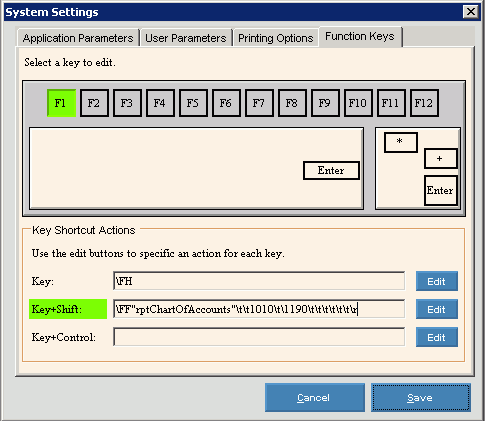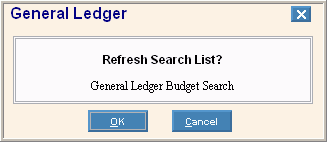Opening System Settings, click More.
1. To open System Parameters from the Menu Bar, click File.
2. Click System
Settings.
Tip: Or, use the
Keyboard shortcut: [ALT] [f] [s]
System Settings Tabs Example:

Using the Application Parameters Tab, click More.
Use the Application Tab to change the palette of window colors for this module at this PC and to adjust the font size. The window color schemes are maintained in Style Sheets.
System Settings Application Parameters Tab Window Example:

System Settings Application Parameters Tab Prompts |
|
|
To change the appearance the module's windows and the search functions, click the Application Parameters Tab. |
Appearance |
|
Style Sheet |
To choose a color scheme, click one of the options in the drop-down list. Tips:
|
Search |
|
Search Build Type |
Changing the Search Build Type can speed up the search build process. To change the Search Build Type, click an option in the drop-down list.
|
Clear Window |
To specify if a Semantic Search clears the search list results from the previous Search when re-opened, select one of the following options:
|
Auto Reset Window |
To specify if you want to see the confirmation prompt when a Classic Search determines that a Refresh is required to rebuild the Search List, select one of the following options:
|
Show Tip of the Day when starting this application |
To show the tips of the day when starting this application, click to check this box. To omit displaying the tips of the day when starting this application, leave this box blank. |
|
To apply the changed settings and close the window, click Save or press [ENTER]. Keyboard shortcut: [ALT + s] |
|
To exit without changing the settings, click Cancel. Keyboard shortcut: [ALT + c] |
Using the User Parameters Tab, click More.
Use the settings in the User Parameters Tab to specify the module's interfaces with third-party software applications and to specify settings for handling account actions and images.
System Settings User Parameters Tab Example:

System Settings User Parameters Tab Prompts |
|
|
To change the user settings, click the User Parameters Tab. |
Microsoft Word Active |
To specify if the module interfaces with Microsoft® Word, click one of the following options in the drop-down list.
|
Microsoft Excel Active |
To specify if this module interfaces with Microsoft Excel, click one of the following options in the drop-down list.
|
Microsoft Access Active |
To specify if this module interfaces with Microsoft Access, click one of the following options in the drop-down list.
|
Account Actions |
|
Check for Account Actions On Load |
To check if an action is specified for an account in the Action Console, click one of the following options in the drop-down list.
|
Show Account Actions on Load |
To show account actions from the Action Console when loading an account, click one of the following options in the drop-down list.
|
Image Settings |
|
Allow Image Settings |
To activate the image shortcut menu, which allows you to set image options and magnify the image, click one of the following options in the drop-down list.
|
|
To apply the changed settings and close the window, click Save or press [ENTER]. Keyboard shortcut: [ALT + s] |
|
To exit without changing the settings, click Cancel. Keyboard shortcut: [ALT + c] |
Using the Printing Options Tab, click More.
Use the Print Tab to control the printer selection when launching any print job within the module. For more information about printing and setting up your printer, refer to Printing Options and Printer Setup.
Note: Any printer number, other than the Print View printer number, overrides the Windows® printer prompt when you click the Print button.
System Settings Printing Options Tab Example:

Printing Options Tab Prompts |
|
|
To change the print settings, click the Print Tab. |
Print Type |
To control the printer prompt, click the appropriate button:
|
Reports |
|
Print Selection Criteria |
To specify if you want to print the selection criteria on reports, click one of the following options in the drop-down list:
|
Report Opens Maximized |
To indicate that you want the report printout to open and fit to the full width of the screen, click to check the box. To open the report printout window less than full maximized, leave this box blank. Tip: This option pertains to printing to the screen. |
Print Bold |
To display the report with bold print on the screen, click to check this box. Otherwise, leave blank. |
Close Report Forms when printing to a physical printer |
When printing to a physical printer, to close the report window after the printer is selected, click to check this box. Or, to leave the report window open after the printer is selected, when printing to a physical printer, leave this box unchecked. |
|
To apply the changed settings and close the window, click Save or press [ENTER]. Keyboard shortcut: [ALT + s] |
|
To exit without changing the settings, click Cancel. Keyboard shortcut: [ALT + c] |
Using the Function Keys Tab, click More.
Use the Function Keys tab for programming the function keys [F1] through [F12] to quickly perform commands according to your personal needs. In addition to [F1] through [F12] you can combine a function key with [CTRL] or [SHIFT] allowing you to program up to 36 function keys. Function Keys are different than keyboard shortcuts. A Function Key can be assigned to perform many operations or commands in addition to menu selections. Function keys are assigned at the PC level.
Notes:
Function key programming is not available in some module releases.
You can not combine a function key with both [CTRL] and [SHIFT] together.
To see details about defining function keys, refer to the Programmable Function Keys directions.
General Ledger System Settings Function Key Tab Example - Programming F1:

In this example, when you press...
[F1] WebHelp displays.
Tip: WebHelp is the default for [F1].[SHIFT + F1] Opens the prompt for the Chart of Accounts Report.
[CTRL + F1] Opens Enter Manual Transactions.




